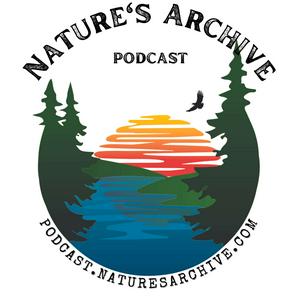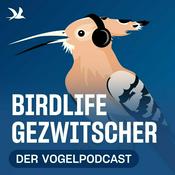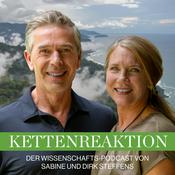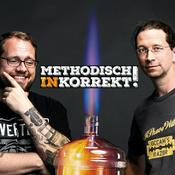Verfügbare Folgen
5 von 128
- #123: A Look at Biodiversity2025 has been an exciting and diverse year for Jumpstart Nature and Nature's Archive, and to celebrate, we're bringing you a special compilation centered on the critical theme of biodiversity. Today, we look back at two of our most fascinating episodes from the year, featuring species and habitats that are essential—yet often overlooked—components of the global ecosystem. From the subtle, but powerful, impact of a parasitic plant that acts as a keystone species in its habitat to the amazing, unseen diversity thriving in dynamic marine environments, prepare to explore the complex web of life.To round things out, we offer a preview from an upcoming episode focused on the fascinating world of aphids. Often dismissed as simple garden pests, these tiny insects are sometimes called the "plankton of the land" due to their sheer numbers and critical role in the food chain. Join us as we re-listen to the stories of life’s intricate connections and get a tantalizing glimpse into the world of aphids, all through the lens of biodiversity.And thanks so much for being part of our community, and a listener to our podcast! We're excited to share more with you in 2026, covering topics from climate-informed conservation, to exciting discoveries on the road to recovering the sunflower sea star, to incredible aphids (yes, you read that right!), and the ecology of salt lakes.A big thank you to Amelia Heintz-Botz for helping to put today's episode together!FULL SHOW NOTESSupport Us On Patreon!Buy our Merch!Music: Spellbound by Brian Holtz MusicLicense (CC BY 4.0): https://filmmusic.io/standard-licenseArtist site: https://brianholtzmusic.com Discover the Jumpstart Nature Podcast - entertaining and immersive, it's the nature fix we all need.Check past Nature's Archive episodes for amazing guests like Doug Tallamy, Elaine Ingham, and Rae Wynn-Grant, covering topics from bird migration to fungi to frogs and bats!--------1:01:11
- #122: Leave the Leaves: Hidden Layers of Benefit with David MizejewskiIf you’ve been following Nature’s Archive for a while, you might be familiar with the idea of “leave the leaves”. It represents one simple act of omission - not raking, blowing, or mulching leaf fall - that is resoundingly positive for the environment.But even if you think you know why leaving the leaves is helpful, I invite you to listen to today’s guest, National Wildlife Federation naturalist David Mizejewski.If you are unfamiliar with David - let me just tell you his skill and enthusiasm for nature interpretation is second to none. Today, David walks us through all the ways leaves help the environment - and how bagging them up and sending them to a landfill makes a bad situation much worse.We also discuss useful tips for keeping leaves even if you have an HOA or difficult neighbors who might think you are neglecting your space. So if you still have leaves in your yard, please listen and take NWF’s pledge to leave the leaves, and reap the rewards for years to come.Be sure to follow David on instagram, and get David's Book "Attracting Birds, Butterflies, and Other Backyard Wildlife". FULL SHOW NOTESPeople and OrganizationsNWF Certified Wildlife HabitatNWF’s Pledge to Leave the LeavesBooks and Other ThingsAttracting Birds, Butterflies, and Other Backyard Wildlife - by David MizejewskiSupport Us On Patreon!Buy our Merch!Music: Spellbound by Brian Holtz MusicLicense (CC BY 4.0): https://filmmusic.io/standard-licenseArtist site: https://brianholtzmusic.com Discover the Jumpstart Nature Podcast - entertaining and immersive, it's the nature fix we all need.Check past Nature's Archive episodes for amazing guests like Doug Tallamy, Elaine Ingham, and Rae Wynn-Grant, covering topics from bird migration to fungi to frogs and bats!--------1:00:26
- Critical Mast: Acorn Woodpeckers and Oak Masting with Dr. Walt KoenigAs a nature lover, I’m often asked about my favorite plants, animals, and insects. And I always struggle to answer those questions, because I have so many favorites, and they are context dependent. But when it comes to birds, woodpeckers often come to mind first. They’re often colorful, charismatic, and have such an amazing set of adaptations that let them drill into trees, excavate insects from bark, and some even fly catch on the wing. One of the most interesting woodpecker species is the Acorn Woodpecker, found in much of the west and southwest. They live in large groups, are loud, have a clown face, and can store thousands of acorns in specially drilled holes that are just acorn sizes.Today’s guest is Dr. Walt Koenig, who has spent several decades studying these birds, in affiliation with the Cornell Lab of Ornithology and UC Berkeley. Today we’ll learn about their behaviors, why you don’t find acorn woodpeckers in the east, despite a nice variety of oak trees, and get this - acorns aren’t even their preferred food! Dr. Koenig has studied their breeding behaviors and group compositions, which is perhaps the most fascinating part of the interview, and I can’t do it justice in a short intro - so you’ll just have to listen.And if one studies acorn woodpeckers, it follows that one studies acorns, too. So we also discuss the phenomenon of masting - that is, when oak trees produce bumper crops of acorns, in synchrony across wide geographic ranges! In fact, this past year was a mast year for some oak species in California. So if you are interested in what causes masting, you might want to jump to the last 23 minutes or so of the interview.This re-release of our popular interview with Dr. Koenig is part of a playful exercise in community podcasting, with 6 different shows each producing their own stories about or inspired by the mystery of masting, and releasing them at (approximately) the same time. For other masting stories, check out:Future EcologiesGolden State NaturalistLearning from Nature: The Biomimicry PodcastJumpstart NatureOutside/InWe’ll populate this Spotify playlist with all our stories as they come out!FULL SHOW NOTESSupport Us On Patreon!Buy our Merch!Music: Spellbound by Brian Holtz MusicLicense (CC BY 4.0): https://filmmusic.io/standard-licenseArtist site: https://brianholtzmusic.com Discover the Jumpstart Nature Podcast - entertaining and immersive, it's the nature fix we all need.Check past Nature's Archive episodes for amazing guests like Doug Tallamy, Elaine Ingham, and Rae Wynn-Grant, covering topics from bird migration to fungi to frogs and bats!--------1:18:03
- #121: Metamorphosis: The Actor Who Became a Butterfly Scientist - Liam O'BrienNearly every great story involves a transformation. In the butterfly world, we call it metamorphosis—the mysterious process where a caterpillar seemingly dissolves itself and is miraculously rebuilt into a creature that takes to the sky. Our guest today is a living parallel to that transformation.Liam O'Brien started his career far from the wild, under the bright lights of the stage as a professional actor. Yet, a shift was coming. At a pivotal time in his life, he traded the scripts and the spotlight for the quiet, meticulous study of winged beauty, stepping into the world of lepidoptery.This pivot wasn't just a career change; it was a profound reawakening. In the precision and fragile beauty of the Bay Area's butterflies, Liam not only found a new scientific passion but he also re-discovered his dormant talent for art. He began documenting his observations with exquisite, original drawings, blending science and creativity in a way only he could.The final form of this incredible journey is his beautifully illustrated Butterflies of the Bay Area - and slightly beyond.Today, Liam discusses what makes butterflies so amazing. We discuss how no matter where you live, there are discoveries to be made. And this interview is so much more than just butterflies. You’ll have to listen to hear the raw, jaw dropping story of what led Liam to this life change.And as you’d expect from a stage actor, Liam is full of charismatic and entertaining stories. And while we get into the details of some specific butterflies and places of the Bay Area, rest assured - there are parallels no matter where you live.You can find Liam at robber_fly on instagram, and check out the show notes for links to Heyday Press and his book. And thanks to Amelia Heintz-Botz for editing help with this episode!FULL SHOW NOTESButterflies of the Bay Area and (Slightly) Beyond - Liam's beautiful new bookADDITIONAL LINKSLiam's public appearancesThe Lepidopterists’ SocietyBooksDangerous World of Butterflies by Peter LauferKaufman Field Guide To Butterflies Of North AmericaRelated Podcast Episode#46: Paul Johnson - Finding and Counting ButterfliesSupport Us On Patreon!Buy our Merch!Music: Spellbound by Brian Holtz MusicLicense (CC BY 4.0): https://filmmusic.io/standard-licenseArtist site: https://brianholtzmusic.com Discover the Jumpstart Nature Podcast - entertaining and immersive, it's the nature fix we all need.Check past Nature's Archive episodes for amazing guests like Doug Tallamy, Elaine Ingham, and Rae Wynn-Grant, covering topics from bird migration to fungi to frogs and bats!--------51:30
- #120: Just Listen: Amy Martin on the Unheard World Around UsIt was a surprisingly warm late February day. Needing to recharge, I drove to a park near Lincoln, Nebraska. When I arrived, I saw something new on the far side of the reservoir: what looked like massive white and gray boulders, lined up along the length of the dam.Then, in one astonishing moment, all of these boulders lifted out of the water, taking flight simultaneously by the thousands. My mind couldn't make sense of what I was seeing, and then the sound hit me. It was thousands of snow geese, a deafening cacophony of honking and wing flapping that washed over me, cleansing my stress and reinvigorating my spirit.Fast forward 20 years to today. Anytime I see snow geese take flight, I instinctively replay this experience, renewing me yet again.And I have so many of these lived experiences. It’s the magic of sound.Today's guest, Amy Martin, is the creator of the incredible Threshold podcast. The current season, Hark!, is an immersive experience all about listening to the natural world. As the podcast website says, "In this season of Threshold, we investigate what it means to listen to the nonhuman voices on our planet—and the cost if we don't."Today, we'll dive into some of the highlights of the Hark season - ranging from dolphins to tree hopper insects. And we’ll explore how listening is a deeply personal and distinct experience for everyone.I’m incredibly excited to share this episode with you today.You can find the Peabody award winning Threshold podcast on any podcasting app or at thresholdpodcast.org. You can also follow @thresholdpodcast on instagram, Facebook, YouTube - and Amy on her Substack called Letters to Earthlings. FULL SHOW NOTES (with pictures!)LinksFind Threshold Podcast at thresholdpodcast.org and follow @thresholdpodcast on instagramLetters to Earthlings - Amy's Substack newsletterEvelyn GlennieRex Cocroft - the Treehopper acoustics researcherSupport Us On Patreon!Buy our Merch!Music: Spellbound by Brian Holtz MusicLicense (CC BY 4.0): https://filmmusic.io/standard-licenseArtist site: https://brianholtzmusic.com Discover the Jumpstart Nature Podcast - entertaining and immersive, it's the nature fix we all need.Check past Nature's Archive episodes for amazing guests like Doug Tallamy, Elaine Ingham, and Rae Wynn-Grant, covering topics from bird migration to fungi to frogs and bats!--------50:20
Weitere Wissenschaft Podcasts
Trending Wissenschaft Podcasts
Über Nature's Archive
Nature’s Archive, hosted by Michael Hawk, delves into the beauty and complexity of the natural world through interviews with ecologists, naturalists, educators, authors, and researchers. Each episode inspires curiosity and reveals nature’s surprising nuances. Part of Jumpstart Nature, a movement empowering everyone to support the environment, this podcast invites you to connect with nature like never before.
Podcast-WebsiteHöre Nature's Archive, Rätsel der Wissenschaft und viele andere Podcasts aus aller Welt mit der radio.at-App

Hol dir die kostenlose radio.at App
- Sender und Podcasts favorisieren
- Streamen via Wifi oder Bluetooth
- Unterstützt Carplay & Android Auto
- viele weitere App Funktionen
Hol dir die kostenlose radio.at App
- Sender und Podcasts favorisieren
- Streamen via Wifi oder Bluetooth
- Unterstützt Carplay & Android Auto
- viele weitere App Funktionen


Nature's Archive
Code scannen,
App laden,
loshören.
App laden,
loshören.





































